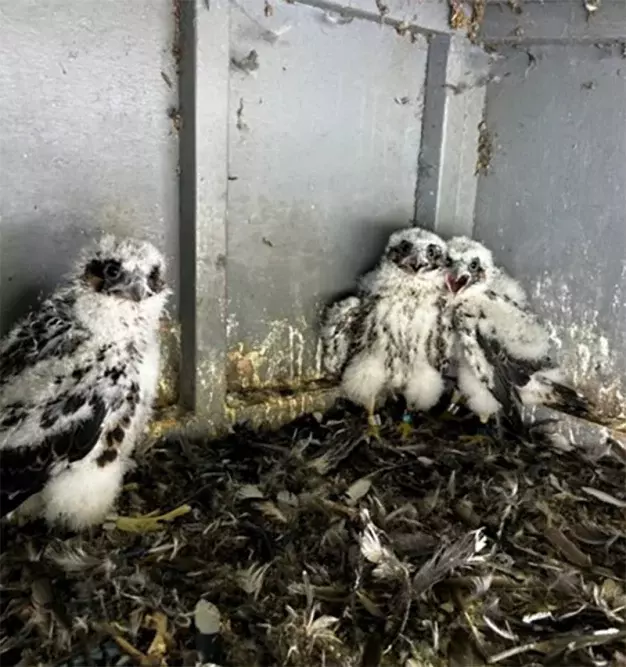It’s been another successful summer for the resident peregrine falcons at the Sault Ste. Marie International Bridge, with the pair of nesting raptors successfully raising three chicks this year.
Karl Hansen, bridge engineer for the International Bridge Administration (IBA), gave an update on the pair of peregrines in the U.S. side nest box. It’s not currently known if it is the same pair that has nested on the bridge between the U.S. and Canada for years.
The chicks, a male and two females, were banded by a Michigan Department of Natural Resources (MDNR) team on June 4. Color-coded bands attached to the legs of young birds allow scientists to track the movements, reproductive behavior, and population growth of the falcons. The MDNR had assistance this year from Sault College environmental technologist Brittny White and recent graduate Glo O’Brien.
Nest boxes for the peregrines have been installed on the bridge since 2010, placed at locations that had evidence of past nesting activity. Last year, the resident pair of peregrine falcons hatched four chicks. Over the years, the site has been a great success, hatching 42 falcon chicks since IBA staff started counting the birds, Hansen said.
An interesting illustration of how far the birds can range: one of the birds hatched and banded at the International Bridge was spotted and photographed in the Dominican Republic back in November 2020.
In addition to their leg bands, the peregrine chicks received names. International Bridge staff decided to call the female birds Janet and Barb and the male bird Chum. Janet and Barb were named in honor of retired bridge toll collectors Barb Winowiecki and the late Janet Hotchkiss. Chum was named in remembrance of Janet’s habit of greeting many people as “chum.”
Several years ago, the IBA added a video camera trained on the nest box, the “FalCam.” The live video stream, which has become very popular, is viewable at www.saultbridge.com/falcam, offering bird watchers a front row seat for the seasonal activities of the endangered raptors. The best time to view the birds is when they’re nesting in the spring.
Michigan lost its peregrine falcons in the 1960s and 1970s due to the use of DDT and other environmental contaminants. Since conservation efforts started in the mid-1980s, the number of peregrines has fluctuated, but has generally increased since the 1990s, according to the MDNR.
The peregrine falcon has been removed from the federal endangered species list but is still listed as an endangered species in Michigan, protected by state and federal law. While they historically nested on cliff faces in Michigan, peregrines have adapted well to city habitats, nesting on tall buildings, smokestacks, bridges, and other man-made structures around the world.
In Canada, peregrine populations have also increased in recent years. Federally, the species is designated “not at risk” in Canada, except for one subspecies listed as of “special concern” on the federal Species at Risk Act.
Of all the active peregrine falcon nesting sites monitored by the MDNR in the Upper Peninsula, the International Bridge is the second-most productive in terms of chicks hatched, behind only a nest on Grand Portal Cliff at Pictured Rocks National Lakeshore.
High-speed hunters capable of flying at 200 mph, the peregrines may help keep populations of nuisance pigeons under control. While researchers have found pigeons make up a relatively small portion of the falcon diet, the dangerous predators may play a role in frightening them away from bridges. Keeping pigeons away is seen as potentially saving the IBA maintenance money down the line, as pigeon droppings can damage paint on metal bridge surfaces.






